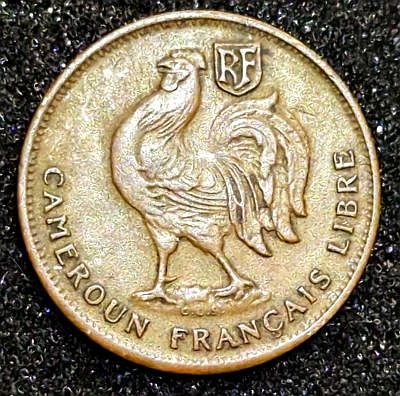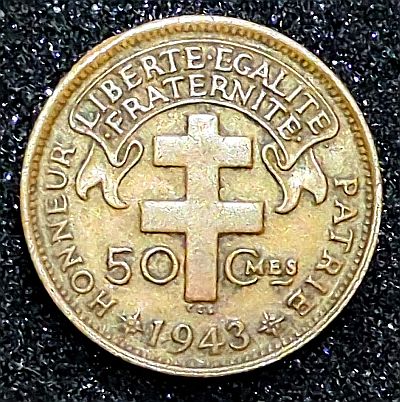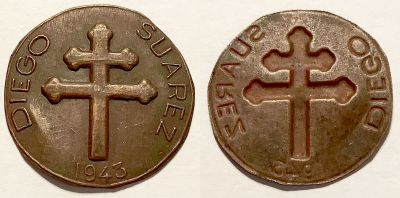A WWII African coin showing support for the exiled Free France government.
French Cameroon

What became Cameroon was originally claimed by Germany as “Kamerun” in the “Scramble for Africa” of the late 19th century. Soon after WWI was declared, French and British troops poured into the country. The dense equatorial rainforest was as much an enemy as the Germans, who retreated to the mountains, more to keep the invaders busy than put up a real fight. The allies partitioned the country, with a section in the north-west joining British Nigeria, and the rest becoming a French protectorate.
This was made official by the League of Nations after WWI, although the French invested more effort into the French Cameroon territory than British investment in British Cameroon.
France fell to German occupation early in WWII, and was nominally run by a puppet government from Vichy, France who were sympathetic to the occupiers. General Charles De Gaulle headed the Free France movement, based in London. He urged France to keep fighting and resisting. He also organised support for Free France by colonies in Africa, India and the Pacific. One of the only holdouts to overseas territory support for Free France was from French West Africa, who supported Marshall Pétain and the Vichy French State.
Following WWII, Cameroon moved slowly towards independence. French officials initially suppressed the movement, which led to civil war. Cameroon achieved independence in 1960.
Obverse
The coin features very patriotic French designs throughout. The text reads “Cameroun française libre” or “Free French Cameroon”. This is an update of an earlier release of the same coin which omitted “libre”. Both coins were issued only in 1943. The two images on the obverse are a shield with RF for “République française” (French Republic), and a rooster. In the Middle Ages, the Gallic Rooster was widely used as a religious symbol, the sign of hope and faith. It was during the Renaissance that the rooster began to be associated with the emerging French nation. During the French Revolution, and subsequent revolutions and periods of republic, the rooster has featured on coins and other devices, including on the gates of the Élysée Palace.
Reverse

The reverse features several mottos:
Liberté, égalité, fraternité (Liberty, equality, fraternity) is the motto of France and has been used since at least the French Revolution.
Honneur – Patrie (Honour Fatherland) is the motto of the Légion d’honneur and the French Navy.
The coin also features the year, 1943, the mintmark (SA – above the Cross of Lorraine) and the CLS, the initials of engraver Coert Laurens Steynberg.
Cross of Lorraine
The main design on the reverse of the coin is the Cross of Lorraine, also called the Patriarchal cross or archiepiscopal cross or a crux gemina, a cross with two bars.
Around the year 326 A.D. Empress Helena, mother of Emperor Constantine, undertook a journey to the Holy Land. She is said to have acquired several relics of the Passion of Jesus Christ. Several pieces of the True Cross were stored in reliquaries in the form of a cross with two bars. The top bar represents the Titulus, the inscription that was placed on the cross which read INRI, the acronym for the Latin phrase “Iesvs Nazarenvs, Rex Ivdæorvm” (Jesus the Nazarene, King of the Jews).
The Cross of Lorraine has been used by numerous people and even countries, although it has special meaning in France and has represented the Duchy of Lorraine since 1431. The Cross of Lorraine was the symbol of Free France and the Free French Forces. A symbol of hope and faith in victory, the Free France flag was a traditional tricolour French flag with a red Cross of Lorraine in the center.
The Cross also featured on the coins of Cameroon, French Equitorial Africa and Madagascar.

Here is a medallion with the Cross of Lorraine and the text “Diego Suarez, 1943”. Diego Suarez (now called Antsiranana) is a port city on the northern tip of Madagascar. In 1942, Madagascar was controlled by Vichy-French troops. The allies invaded Madagascar, via this port, in the “Battle of Madagascar” which lasted from May until November 1942. Once liberated, the island was placed under Free France control.


Leave a Reply